Seeking plants perfect for shady areas? Your search ends here! This updated 2025 guide presents 34 shade-loving plants to illuminate your garden’s darker recesses. Find vibrant blooms, rich greenery, and easy-care choices. These plants will transform low-light spaces into flourishing green havens. Explore and select the ideal additions for your shaded garden!
Lungwort: Charming Ground Covers
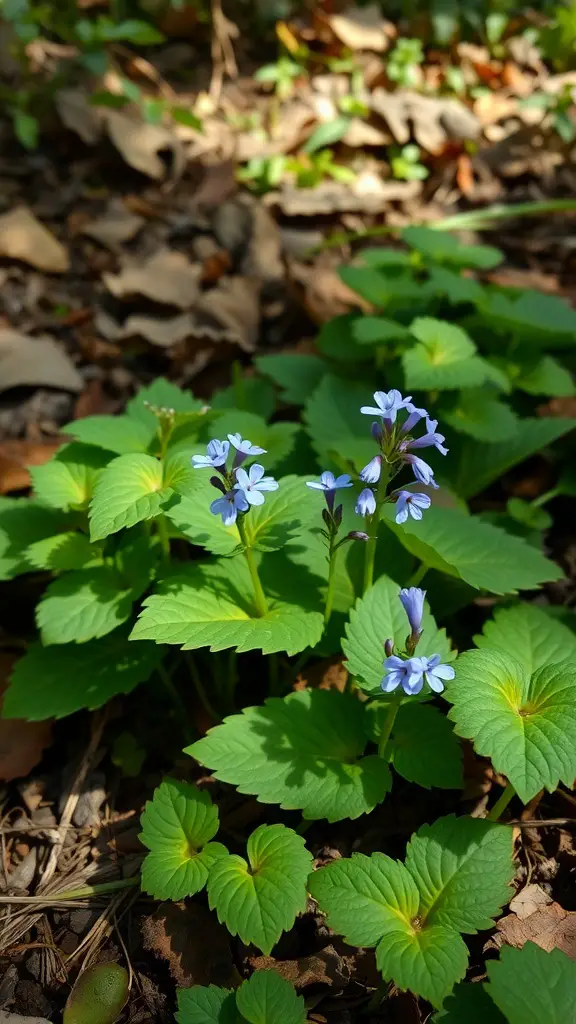
Lungwort remains a top pick for 2025 shade gardens, as showcased in the stunning photo above. Its charming blue flower clusters beautifully contrast with the rich green foliage. These delicate blossoms bring a cheerful splash of color to any shaded area.
This plant flourishes in damp, well-draining soil. It’s ideal for covering bare patches, especially in those challenging, shady garden spots. Its attractive leaves boast a texture and hue that can truly illuminate any dark corner.
Beyond their stunning appearance, lungworts are incredibly easy to care for. They need minimal attention and naturally expand to cover areas. This makes them an excellent option for gardeners wanting to brighten shady spots with little effort.
Hostas: Versatile Foliage Varieties
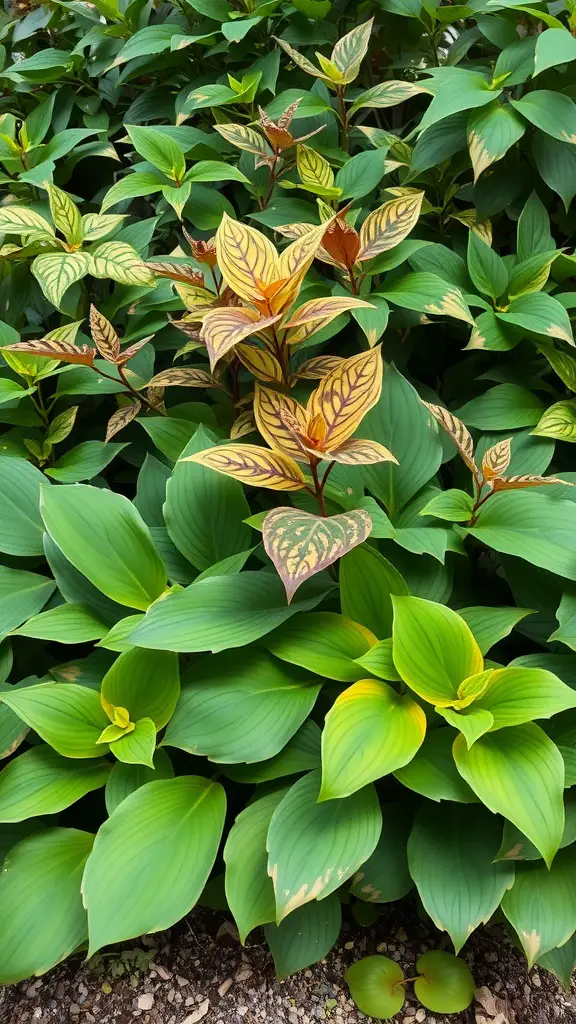
Hostas remain a top pick for shaded gardens, and their appeal is clear. This photo displays a diverse collection of hosta leaves, featuring various green tones and striking patterns. Every leaf stands out, bringing personality to any garden.
Lush, vibrant greens create a stunning backdrop. Intricate patterns on lighter leaves add a touch of excitement. Hostas offer diverse options, from solid colors to multi-colored varieties, perfect for creative landscaping in 2025.
Hostas are incredibly versatile, making them a gardener’s favorite. They flourish in various soil conditions. They’re ideal for those challenging, shaded areas in your garden. As they mature, they form beautiful foliage mounds, significantly boosting your landscape’s appeal. Expect even more resilient and vibrant varieties in 2025!
Hostas elevate your 2025 garden design, fostering tranquility and charm. Combine them with complementary shade plants or distinctive garden art for a personalized space. Diversity is essential, and hostas are a perfect choice.
Astilbe: Colorful Flowering Powerhouses

Looking to brighten your garden? Astilbes are an excellent option! These plants boast stunning, feathery flower plumes. Expect vibrant hues of pink, white, and red. The picture highlights the captivating pink blossoms. They create a beautiful contrast with the rich green leaves.
These shade-loving plants flourish in low-light conditions. They’re perfect for gardens with limited sun exposure. Beyond their beauty, they draw in vital pollinators such as bees and butterflies. This boosts your garden’s overall ecological health.
Astilbes are simple to maintain. Consistent moisture is key, particularly in the heat of summer. Water them regularly to maintain their vibrant appearance. They add a delightful charm to any garden, whether grouped together or planted individually.
Planning to include Astilbe in your garden? Consider combining them with ferns or hostas for a rich, multi-layered display. Their vibrant flowers will illuminate shaded areas, crafting a serene escape in your garden.
Brunnera: Forget-Me-Not Alternatives

Brunnera, also called Siberian Bugloss, is a garden gem. Its brilliant blue flowers resemble forget-me-nots. The picture shows Brunnera’s heart-shaped leaves and vibrant blue blooms. They bring a burst of color to shaded areas.
These shade-loving plants flourish in areas with limited sunlight. Their vibrant green leaves provide a beautiful contrast to the stunning blue blossoms. Enjoy a tranquil garden atmosphere with these easy-to-grow beauties.
Brunnera’s beauty is matched by its easy care. After settling in, it gently expands, creating appealing ground cover. Perfect for filling spaces or softening borders, it complements ferns and hostas, boosting your shade garden’s charm.
Seeking a forget-me-not substitute? Brunnera offers stunning beauty and simple upkeep. It will undoubtedly add vibrancy and delight to your garden.
Heuchera: Colorful Leaf Varieties
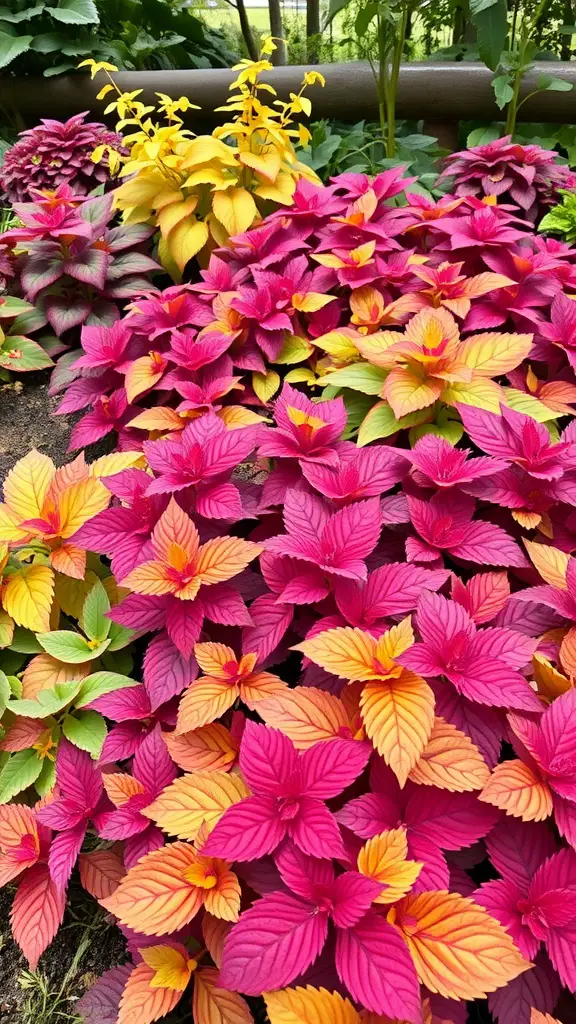
Coral bells, or Heuchera, are perfect for brightening shady gardens with lively hues. The picture displays a beautiful collection of Heuchera, emphasizing their colorful foliage in pink, orange, and green tones.
These plants do more than look good. They bring vibrant colors to areas with little sunlight. Their leaves boast varied shapes and textures, appealing to all gardeners. The colorful mix creates an energetic and cheerful garden atmosphere.
Beyond their stunning appearance, Heuchera plants are incredibly resilient. They flourish in partial or full shade and require minimal upkeep. This allows you to appreciate their beauty effortlessly. Heuchera’s adaptability makes it perfect for borders or filling empty spaces, revitalizing shaded areas in your garden.
Elevate your 2025 garden with diverse Heuchera cultivars, ensuring vibrant color year-round. The extensive selection guarantees a perfect fit for any garden aesthetic and personal taste.
Japanese Maples: Striking Focal Points
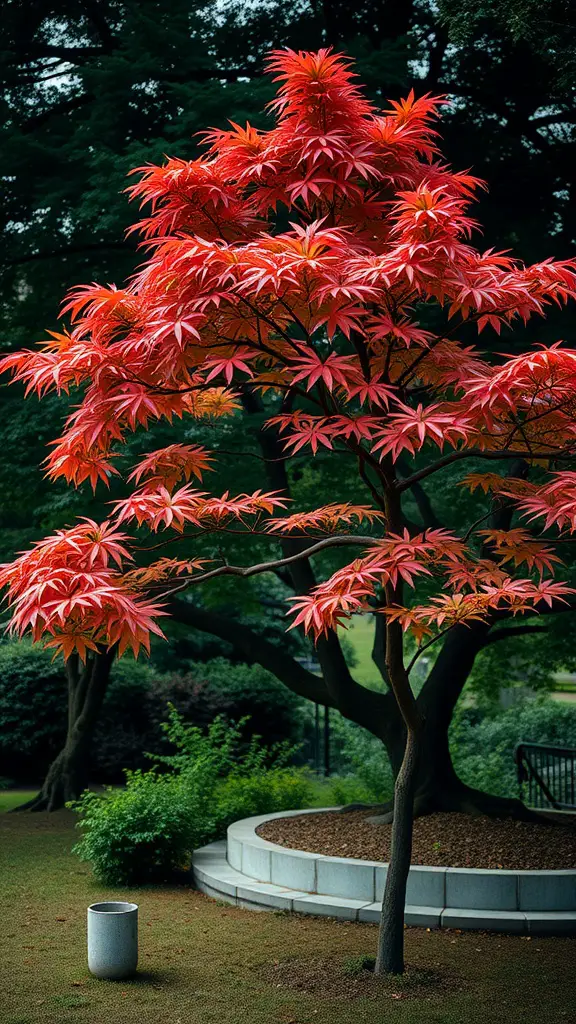
Japanese maples remain a garden favorite. Their bright leaves bring vibrant color, especially during autumn. The leaves transform into stunning reds. This specific tree offers a remarkable display of these fiery shades. It becomes a truly captivating centerpiece.
The towering tree boasts gracefully arching branches. This design offers both beauty and a peaceful atmosphere. Nearby plants enhance its appeal, forming a balanced garden scene.
Elevate your garden with a Japanese maple. This stunning tree becomes a focal point, whether standing solo or nestled within a landscape. Ideal for shady spots, it provides exceptional beauty with minimal direct sunlight.
Elevate your shade garden with the stunning Japanese maple! These trees flourish in partial shade. They also adapt to different soil conditions, offering flexible planting choices for 2025 gardens.
Tiarella: Foamy Flowering Ground Covers
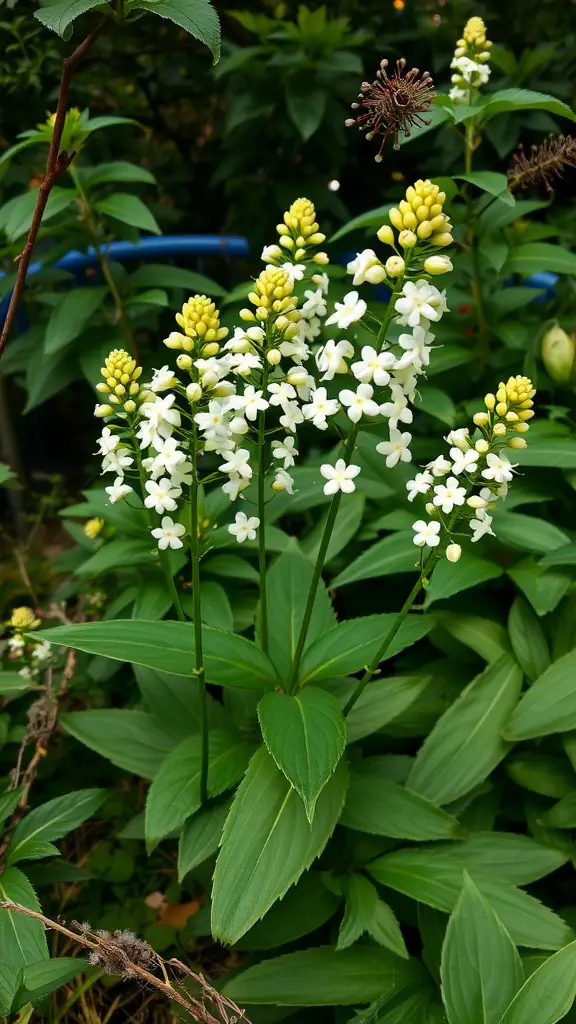
Tiarella, commonly called foam flower, enhances any shady garden. This image showcases a group of its lovely white blooms, elegantly rising above vibrant green foliage. These blossoms provide beauty and a gentle, frothy appearance, reminiscent of foam, thus inspiring its name.
This plant flourishes in areas with partial or complete shade. It’s perfect for those challenging garden locations with minimal sunlight. Its heart-shaped foliage provides a beautiful setting for the dainty blossoms, usually emerging in springtime. When these flowers bloom, they draw in pollinators such as bees and butterflies, enlivening your garden space.
Adding Tiarella to your garden is simple. These plants thrive in moist, well-drained soil. Once established, they can handle some dry conditions. This makes them ideal for ground cover in shady spots. They also need little upkeep, staying vibrant with minimal effort.
Seeking a plant that blends delicate beauty with effortless maintenance? Tiarella is an excellent choice. It introduces captivating visual appeal to shaded gardens and benefits local wildlife. Embrace the subtle allure of this delightful ground cover!
Ferns: Elegant Greenery Options
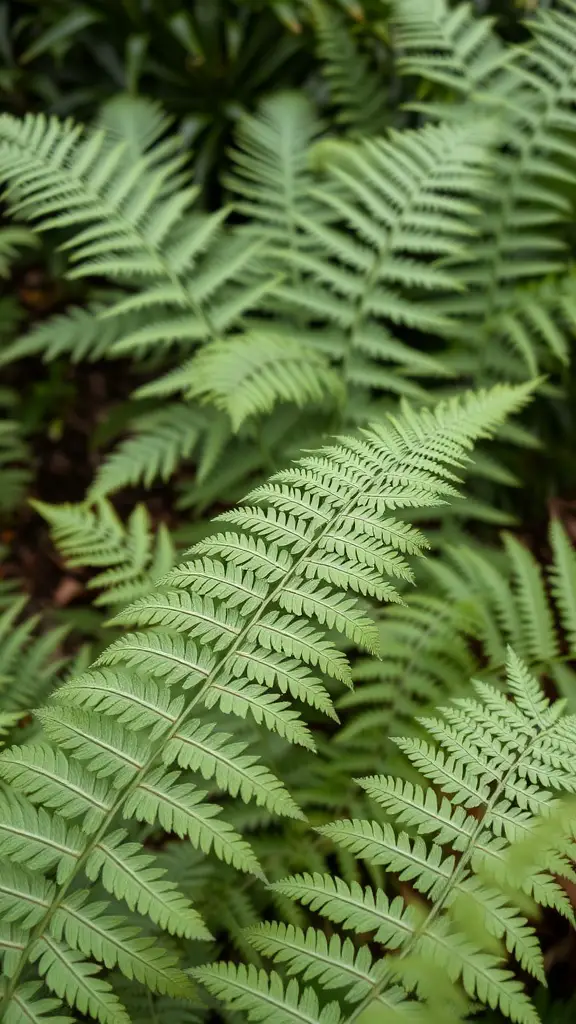
Ferns remain a fantastic choice for enhancing any shaded garden in 2025. Their vibrant, delicate foliage introduces a calming and sophisticated atmosphere. This image highlights diverse fern fronds, revealing their intricate textures that can revitalize any area with natural beauty.
These shade-loving plants flourish in dimly lit environments. They’re ideal for challenging locations beneath trees or close to structures. Diverse varieties offer unique forms and dimensions, enhancing your garden’s aesthetic appeal.
Ferns are simple to maintain and boost soil health. Their growth fosters a nutrient-rich environment, benefiting nearby plants. They also draw in wildlife, like birds and insects, enriching your garden’s ecosystem.
Elevate your shade garden by combining ferns with complementary plants. Achieve a textured effect by pairing them with hostas and astilbes. The ferns offer a lush green foundation, beautifully contrasting with vibrant floral displays.
Pulmonaria: Early Spring Blooms
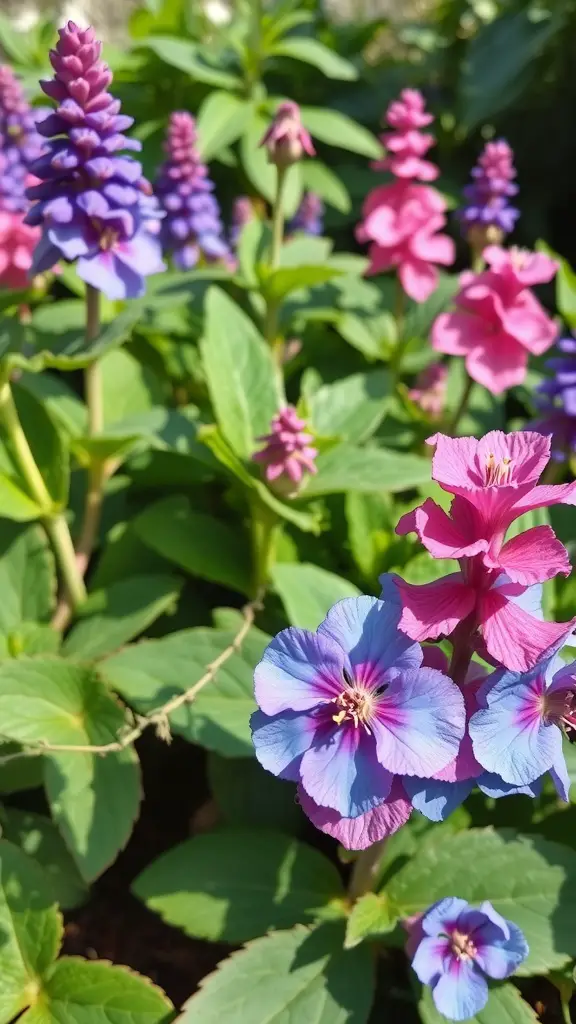
Lungwort, or Pulmonaria, is a delightful choice for shady gardens. This perennial is among the earliest spring bloomers. Its beautiful flower clusters bring vibrant color to the garden after winter’s end.
The picture showcases striking blue and pink flowers rising above vibrant green foliage. Their delicate petals offer a beautiful contrast, making pulmonaria a welcome sight each spring. These blossoms enhance garden aesthetics and draw in bees and other vital pollinators.
This plant flourishes in areas with partial or complete shade. It’s a superb option for gardens where sunlight is limited. Furthermore, it’s quite low-maintenance, requiring only well-draining soil and consistent moisture.
Even after the vibrant flowers disappear, the attractive foliage persists, offering continued visual appeal throughout the growing season. Pulmonaria’s unique color combination and adaptability make it a true treasure for any shade garden enthusiast.
Columbine: Unique Flower Shapes
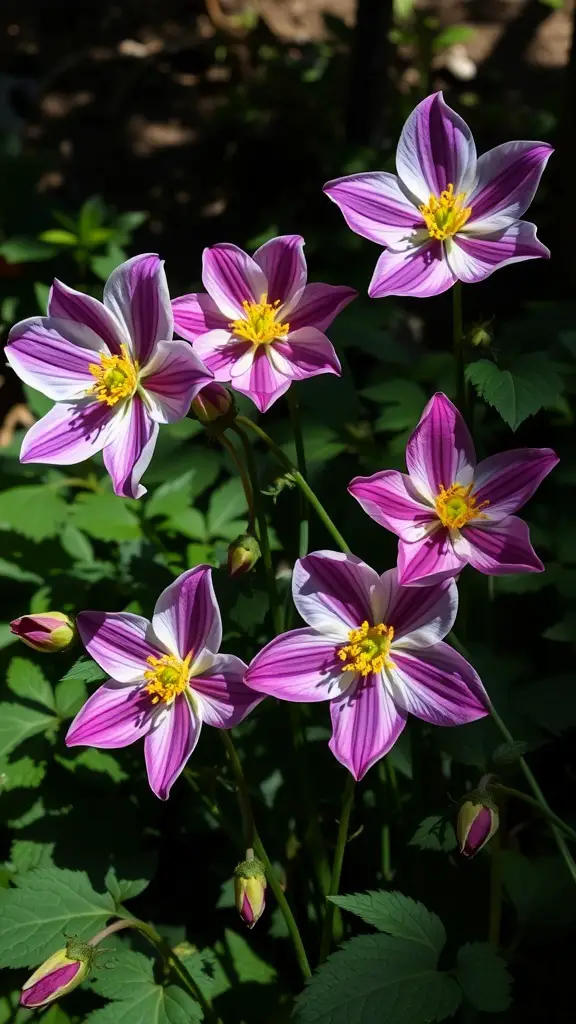
Columbine flowers, celebrated for their distinctive and varied forms, truly enhance any shaded garden. Their captivating petals and brilliant hues inject visual appeal into your outdoor environment. This image beautifully portrays a collection of columbine blossoms, highlighting their fragile beauty and diverse color palette.
Columbine flowers frequently showcase pink and white shades. This pairing offers a beautiful contrast with their green leaves. This vibrant display captures attention and attracts pollinators. Bees and hummingbirds are drawn to their nectar-filled blooms. Adding columbine to your garden enhances its liveliness and creates a dynamic space.
Beyond their stunning appearance, columbines are known for their simple care requirements. They flourish in areas with partial shade, an ideal solution for challenging garden locations lacking direct sunlight. Their distinctive floral forms beautifully enhance other shade-tolerant plants, elevating your garden’s visual appeal.
Bleeding Heart: Romantic Flowering Plants

The Bleeding Heart plant, a garden favorite, boasts distinctive heart-shaped blossoms. These charming flowers hang delicately from curved stems, creating a visually stunning display in any outdoor space. Updated for 2025, this timeless beauty continues to captivate gardeners.
This image showcases a stunning collection of pink and white blossoms, tightly grouped together. Their gentle hues and refined forms evoke a romantic feeling, ideal for gardening enthusiasts. The surrounding foliage provides a vibrant, verdant setting, amplifying the plant’s captivating appeal.
These shade-loving plants are perfect for gardens with limited sunlight. Bleeding Hearts add a whimsical touch to any landscape with their distinctive beauty.
These plants offer beauty and draw in vital pollinators such as bees, boosting your garden’s ecosystem. When planting, ensure consistently moist soil and use mulch to help maintain optimal hydration.
Tradescantia: Colorful and Resilient

Tradescantia, also known as spiderwort, brings vibrant color to shaded gardens. Its striking purple and green foliage offers a beautiful, eye-catching contrast. This plant flourishes in low-light areas, perfect for challenging garden spaces.
Tradescantia’s resilience is a major plus. It’s an easy-care plant, adaptable to different environments. It handles both moist soil and drier conditions effectively. Provide sufficient water, and it will flourish, showcasing its beautiful leaves.
Tradescantia isn’t just beautiful; it’s a butterfly magnet! These plants draw in pollinators, enhancing your garden’s ecosystem. Their vibrant blooms add a touch of magic, enlivening any outdoor space. Tradescantia’s resilience and striking looks make it perfect for adding color to shady areas. It’s an excellent choice for gardeners seeking easy beauty.
Solomon’s Seal: Graceful Arching Stems

Solomon’s Seal is a captivating plant. It brings refined beauty to shaded gardens. The picture showcases its gracefully arched stems. They bend attractively under the weight of dainty, white blossoms. These flowers dangle in clusters. This creates a gentle, flowing aesthetic. It brightens even the darkest areas of your garden.
The foliage is vibrant and verdant, beautifully complementing the pristine white flowers. The resulting ambiance is peaceful and soothing, perfect for creating a serene garden retreat. Solomon’s Seal flourishes in shaded or partially shaded areas, making it an excellent option for gardens with limited sunlight.
Beyond its captivating beauty, this plant showcases remarkable resilience. After it settles in, it needs very little attention. Simply provide well-draining soil, and it will consistently impress you with its gorgeous display. Think about incorporating Solomon’s Seal into your shaded garden for a touch of elegance and simplicity.
Hellebores: Winter-Blooming Beauties

Hellebores, also called Lenten roses, brighten gardens in winter. Their diverse colors and unique patterns are captivating. This image shows a beautiful group of Hellebores. Notice their elegant petals with stunning pink and white stripes.
Hellebores are perfect for shady gardens. These resilient perennials flourish where sunlight is scarce. They bring beauty and attract pollinators during the dormant season. Their vibrant yellow stamens beautifully contrast with delicate petals. This makes them a welcome sight in winter landscapes.
Hellebores thrive in well-drained soil. These hardy plants tolerate frost, blooming even in cold conditions when other plants are dormant. Gardeners appreciate their reliable winter flowers.
Fuchsia: Vibrant Hanging Blooms
Fuchsia plants offer a charming touch to shaded gardens. Their bright pink and purple flowers quickly enhance any area. The image showcases stunning fuchsia blossoms spilling from a hanging basket. The rich pink petals beautifully complement the vibrant green foliage, resulting in an appealing and welcoming scene.
These plants flourish in cool, shady spots. This makes them perfect for gardens with limited direct sunlight. Fuchsias are hummingbird magnets, adding delightful charm to your garden. They excel in hanging planters, where their blossoms cascade freely, creating a breathtaking display.
Fuchsia plant care is straightforward. They thrive in consistently moist soil, requiring frequent watering, particularly when it’s hot. Boost their blooming potential by feeding them a balanced fertilizer every few weeks. With minimal effort, these plants will flourish, gracing your space with beautiful flowers all summer long.
Impatiens: Bright Annual Fillers
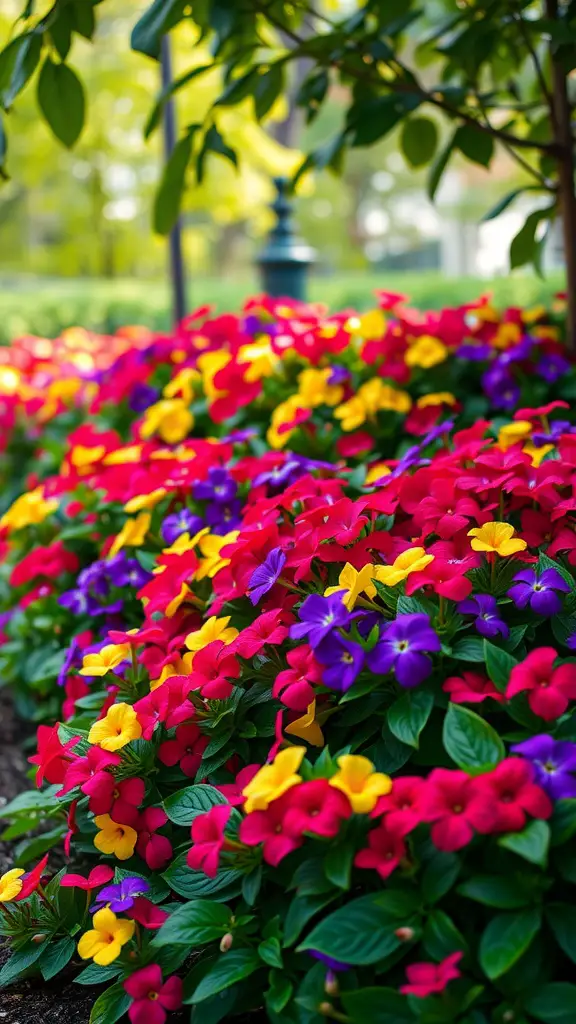
Impatiens remain a top pick for injecting vibrant color into shaded gardens. These annuals offer a spectrum of hues, from fiery reds to sunny yellows and regal purples, just like you see here. Planted en masse, they form a dazzling, colorful groundcover, instantly revitalizing any lackluster area of your outdoor space.
These shade-loving plants flourish in areas with filtered or complete shade. This makes them perfect for challenging locations beneath trees or close to structures where other flowers may not grow well. They need regular watering and some shelter from intense sunlight. However, the beautiful results are definitely worth the care.
Beyond their stunning appearance, impatiens offer remarkable versatility. They thrive in flower beds, hanging baskets, and as garden borders. Expect continuous blooms throughout the summer, guaranteeing a vibrant and welcoming outdoor area.
Begonias: Versatile Container Plants

Begonias remain a popular choice for gardens, thriving particularly well in pots. Their bright flowers and rich foliage provide visual appeal, similar to the begonia pictured. The pink blossoms offer a striking contrast against the dark green leaves, adding a touch of joy to any space. These continue to be a favorite in 2025.
These shade-loving plants are ideal for areas with limited sunlight. They’re simple to maintain and grow well in pots, hanging baskets, or garden beds. The stylish pot in the picture adds a sophisticated touch, improving your outdoor area’s aesthetic.
Choose begonias based on your preferences. Some offer stunning foliage designs, and others display vibrant blooms. This diversity lets you create unique combinations. Ensure they have good drainage and consistent watering for optimal health and beauty.
In conclusion, begonias remain an excellent option for adding vibrant color to shady areas. Their simple care requirements and stunning beauty make them perfect for enhancing your garden or patio in 2025.
Creeping Jenny: Ground Cover Charm

Golden Creeping Jenny, celebrated for its striking chartreuse foliage, elevates any garden space. Its rapid growth habit makes it a superb option for lush ground cover. The image displays a vibrant expanse of Golden Creeping Jenny, its luminous leaves basking in sunlight.
Creeping Jenny’s vibrant hues effortlessly illuminate dim garden spaces. It flourishes in areas with limited sunlight, making it ideal for challenging locations where many plants falter. Beyond its aesthetic appeal, this ground cover effectively suppresses weed growth, ensuring a tidy garden.
Creeping Jenny is also incredibly easy to care for. After it settles in, it needs very little water and adapts to different soil conditions. A quick trim each spring keeps it neat and promotes new growth.
Seeking a low-maintenance plant with captivating appeal? Creeping Jenny is an excellent choice. It’s perfect for crafting attractive garden edges or covering empty areas, making it a versatile and visually pleasing ground cover.
Sweet Woodruff: Fragrant Ground Cover

Sweet Woodruff remains a top pick for shady gardens in 2025. This delightful, low-maintenance groundcover excels in cool, shaded locations. It’s ideal for those challenging areas in your landscape. Its vibrant green foliage creates a dense, soft mat underfoot.
As spring arrives, Sweet Woodruff unveils its charming, petite white blossoms, adding a subtle elegance to any garden. These delightful flowers offer more than just visual appeal; they release a wonderfully sweet and refreshing aroma. Picture yourself strolling through your garden, enveloped by this delightful fragrance!
This attractive plant offers more than just visual appeal. It actively combats weeds, boosting the growth potential of your other plants. As a resilient perennial, it returns annually, ensuring lasting beauty with little maintenance.
Considering Sweet Woodruff for your garden? It’s a breeze to maintain! Ensure adequate moisture and partial shade, and it will thrive. This plant is an excellent option for homeowners wanting to effortlessly elevate their shaded garden spaces.
Foxglove: Tall and Elegant Spires
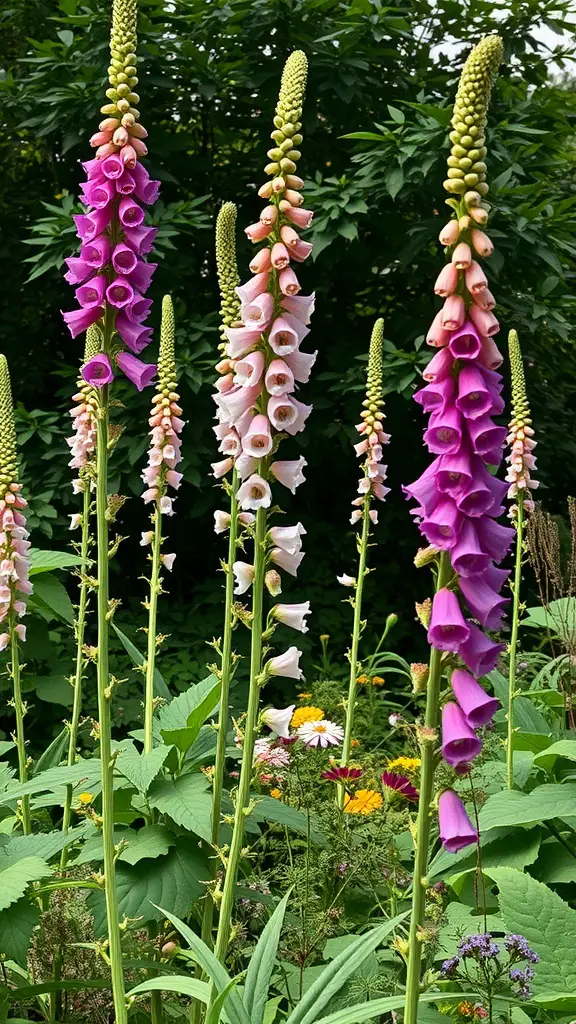
Foxgloves remain a stunning addition to any 2025 garden landscape. These towering, spire-like blossoms offer a vibrant color palette, perfect for illuminating those dimmer garden spots. Notice in the image the striking purple and delicate pink flowers, standing proudly against a backdrop of lush green foliage.
These shade-loving plants flourish in areas with limited sunlight. Their distinctive, tube-shaped blossoms draw in diverse pollinators, enlivening your garden space.
Foxgloves offer beauty and effortless care. They thrive in moist soil and adapt to various conditions. Consistent watering is key, particularly during dry periods.
In 2025, think about combining them with other plants that thrive in shade for a vibrant display. Their tall stature will enhance your garden’s dimension, setting them apart from smaller flowers.
Lily of the Valley: Delicate Fragrance

Lily of the Valley, showcasing its delightful white blossoms, adds a refined touch to any shaded garden space. These beautiful, clustered flowers are celebrated for their sweet and subtle fragrance, capable of infusing your garden with a lovely scent.
These plants flourish in shaded environments, ideal for beneath trees or areas with minimal direct sunlight. Their rich, green foliage creates a striking contrast, enhancing the beauty of their blooms. Furthermore, they require minimal upkeep, making them a favored selection for gardeners seeking dependable shade-loving plants.
Lily of the Valley’s spring blooms offer a welcome sight after winter. These small, bell-shaped flowers are beautiful and attract pollinators. This boosts your garden’s ecosystem. Remember, all parts of this plant are poisonous if eaten!
Pulmonaria: Early Bloomers in Shade
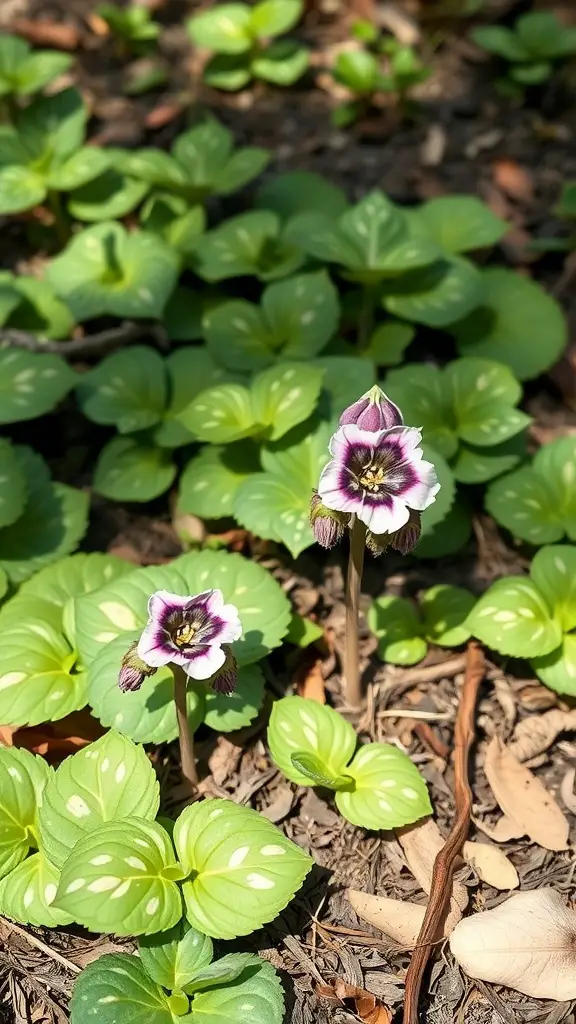
Lungwort, or Pulmonaria, is a fantastic choice for shady garden spots. The picture features two bright flowers rising above rich green foliage. These early-blooming plants bring welcome color to dim areas of your garden.
These blossoms display a striking pattern, blending shades of purple and white for a truly captivating look. The vibrant green leaves surrounding them are just as attractive, frequently showcasing unique speckled patterns. This pairing creates a beautiful visual and a delightful textural contrast, enhancing their overall appeal.
Lungwort flourishes in damp, shady spots. This makes them ideal partners for other plants that prefer shade. When designing your shady garden, think about adding these beautiful plants. They’ll bring vibrancy and color to areas with little sunlight. They bloom early, often before many other plants, offering a joyful spring surprise.
Beyond their visual appeal, Lungwort plants are excellent at drawing in pollinators. This is a significant advantage for gardeners aiming to cultivate a vibrant garden ecosystem. Regardless of your gardening experience, Pulmonaria offers a delightful touch to your shaded garden areas.
Corydalis: Unique Blue Flowers
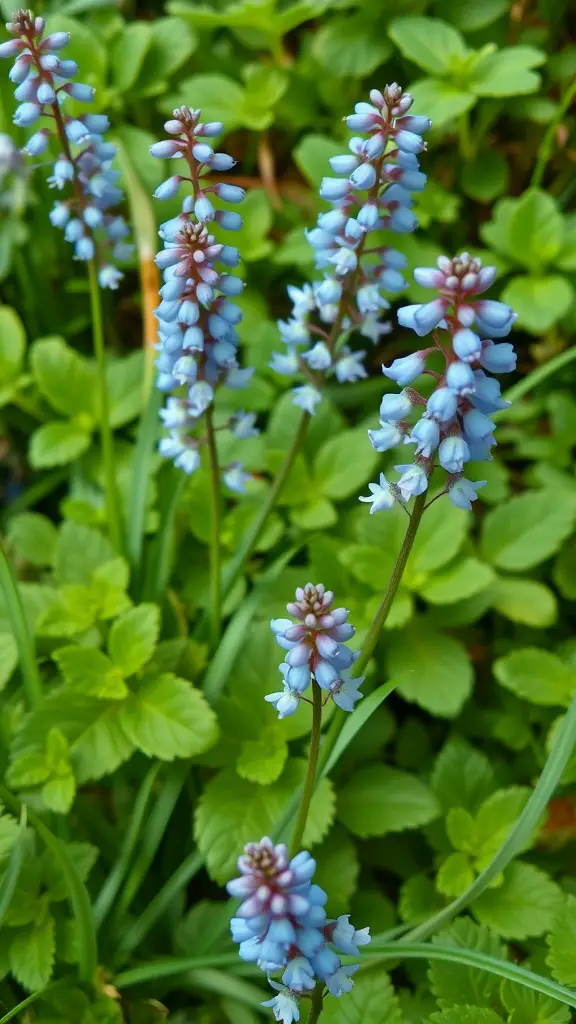
Corydalis captivates with its distinctive blue blooms. These exquisite flowers beautifully contrast the lush green foliage. Expect numerous flower spikes, each displaying a soft color that brightens any shady spot. In 2025, Corydalis remains a garden favorite for its easy care and vibrant display.
These plants flourish in cool, shady spots. They are ideal for your shade garden. They bring color and unique texture. Their upright stems and detailed flowers are striking. The flowers’ gentle blue hue pairs well with other shade plants.
Cultivating Corydalis is straightforward. They thrive in damp, well-draining soil. Expect them to spread readily, covering empty areas in your garden. This translates to reduced upkeep, letting you appreciate their charm effortlessly.
Seeking a unique addition to your garden? Consider Corydalis. Its delicate blue blooms will captivate and infuse serenity into your outdoor haven in 2025.
Acanthus: Bold Architectural Foliage

Acanthus plants truly shine in shaded gardens. Their large, impressive leaves provide a dramatic background for other plants. These uniquely shaped leaves add texture and dimension to your garden space. Together, they create a vibrant green carpet, offering a blend of natural beauty and refined design.
Acanthus plants are known for their striking flower spikes. These impressive blooms, varying from white to rich purple, inject vibrant color into any garden. The flowers rise above the leaves, creating a captivating focal point. This offers a beautiful contrast to the plant’s wide foliage.
Beyond their aesthetic appeal, Acanthus plants are remarkably resilient. They flourish in both partial and full shade. They also adapt to diverse soil compositions. This adaptability makes them ideal for various garden settings. Their growth habit allows them to expand, enriching bare areas with abundant greenery.
Thinking about Acanthus for your garden? They thrive alongside other plants that enjoy shade. Their bold form beautifully contrasts with finer flowers and gentler foliage. This results in a visually appealing, multi-layered design. Acanthus brings a striking element to any garden, an excellent option for enhancing your shaded areas in 2025.
Toad Lily: Exotic, Spotted Flowers
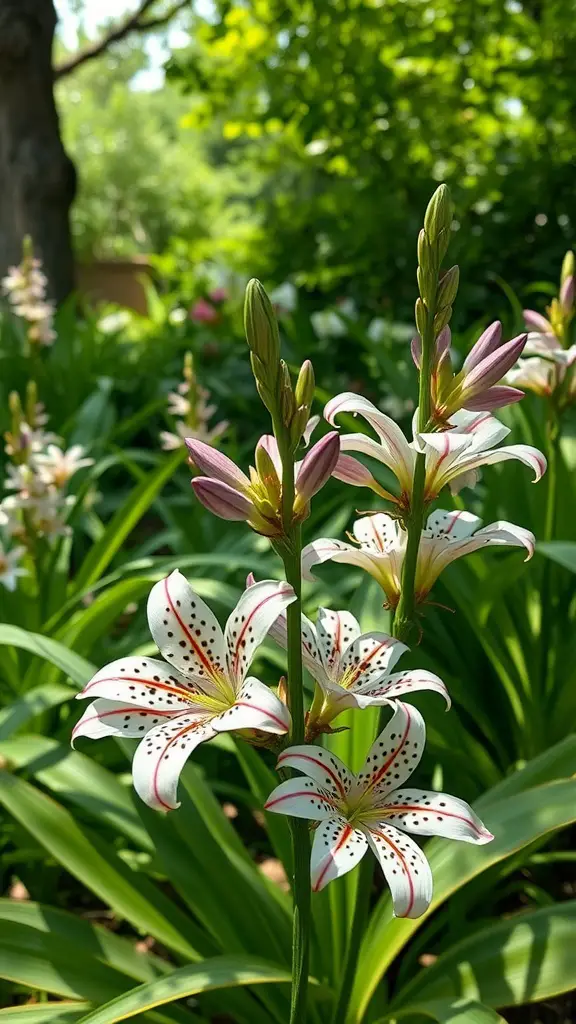
Toad lilies (Tricyrtis) add an exotic flair to shady gardens. Their distinctive, speckled blossoms are truly captivating. The image displays clusters of these lovely flowers. Each bloom features delicate petals adorned with purple spots on a creamy white backdrop.
These shade-loving plants flourish where sunlight is scarce. Their vibrant green leaves create a beautiful setting for the unique blooms. Discovering toad lilies in a garden reveals fascinating details that beckon a closer look.
Toad lilies usually flower from late summer through early autumn. They bring vibrant color to gardens as other perennials fade. These plants are easy to care for and thrive in various soil conditions. This makes them a popular choice for gardeners. Looking to add unique beauty to your garden? These speckled beauties could be ideal!
Cyclamen: Charming Winter Blooms
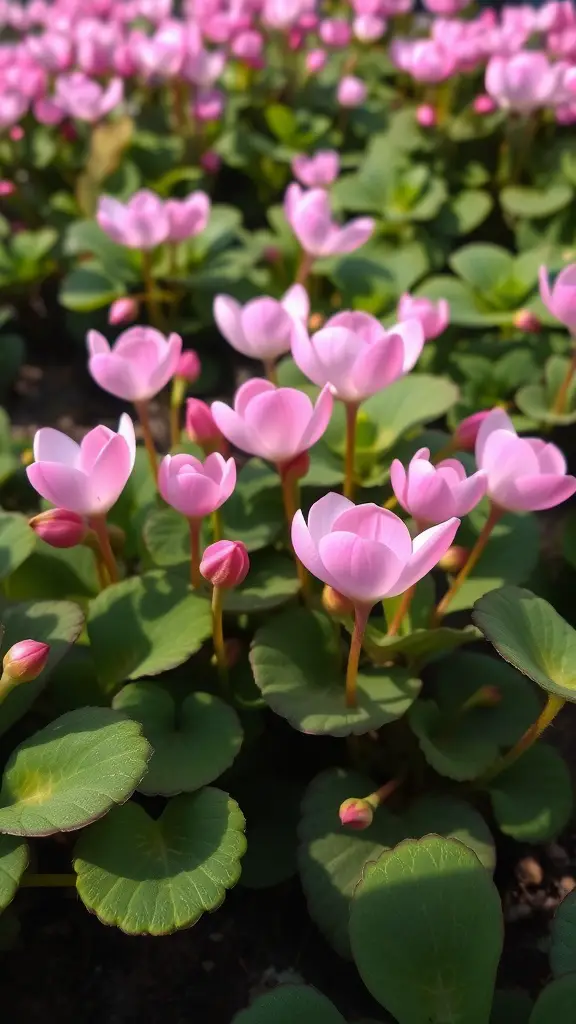
Cyclamen are charming, small plants. They add vibrant color during winter. Their pink flowers stand tall above the green leaves. This creates a joyful display. The photo shows a lively group of cyclamen. Their lovely blooms can brighten any shaded garden spot.
These plants boast distinctive heart-shaped foliage. This adds visual interest to your garden, even when blooms are absent. The delicate pink hues of the flowers create a captivating display. They flourish in well-drained soil and favor cooler climates. This makes them ideal for enhancing winter gardens.
Select a planting spot for your cyclamen that’s shielded from intense sunlight. This protects their fragile flowers and extends their blooming season. Cyclamen are easy to care for, requiring infrequent watering and a little compost for optimal health. Proper care ensures vibrant color and beauty during the winter.
Epimedium: Drought-Resistant Ground Covers
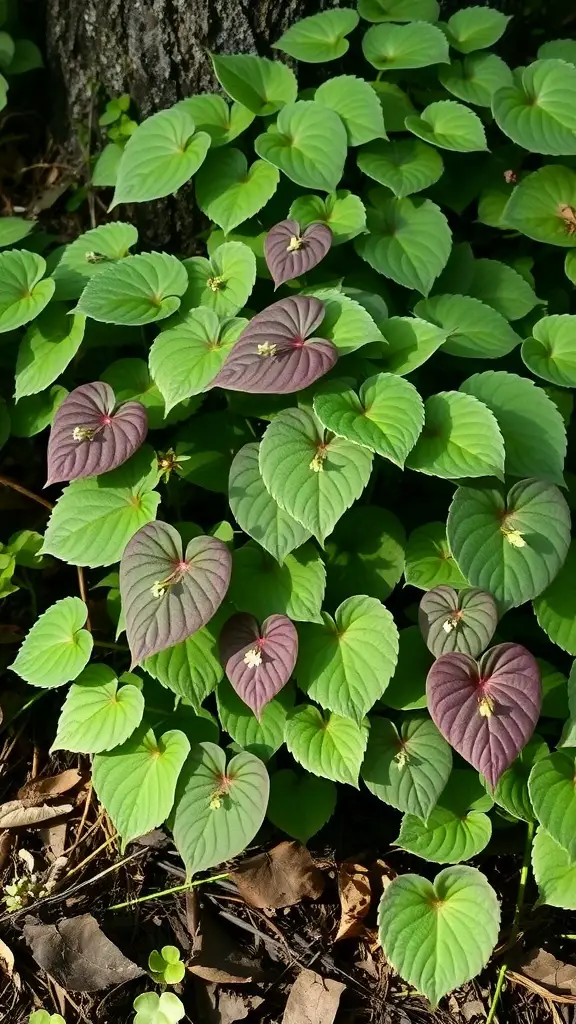
Epimedium, also known as barrenwort, is a fantastic choice for gardens, particularly shady spots. This image displays a vibrant cluster of Epimedium, highlighting its distinctive heart-shaped foliage. Beyond their beauty, these plants are drought-tolerant, making them a smart option for gardeners in 2025.
Lush green leaves, some boasting a deep purple shade, offer a beautiful contrast against the garden floor. This color variation enhances visual appeal and brightens shady areas. Notably, Epimedium excels in challenging environments like dry shade, where many plants struggle to survive.
These ground covers excel at stopping soil erosion, particularly on hillsides. They readily expand, covering bare spots and forming a lush, carpeted effect. Furthermore, their tiny blooms draw in pollinators, boosting your garden’s biodiversity.
In 2025, adding Epimedium to your garden remains a fantastic idea. Beyond its visual appeal, you’re selecting a hardy, low-maintenance ground cover that thrives in various conditions.
Japanese Forest Grass: Graceful Foliage
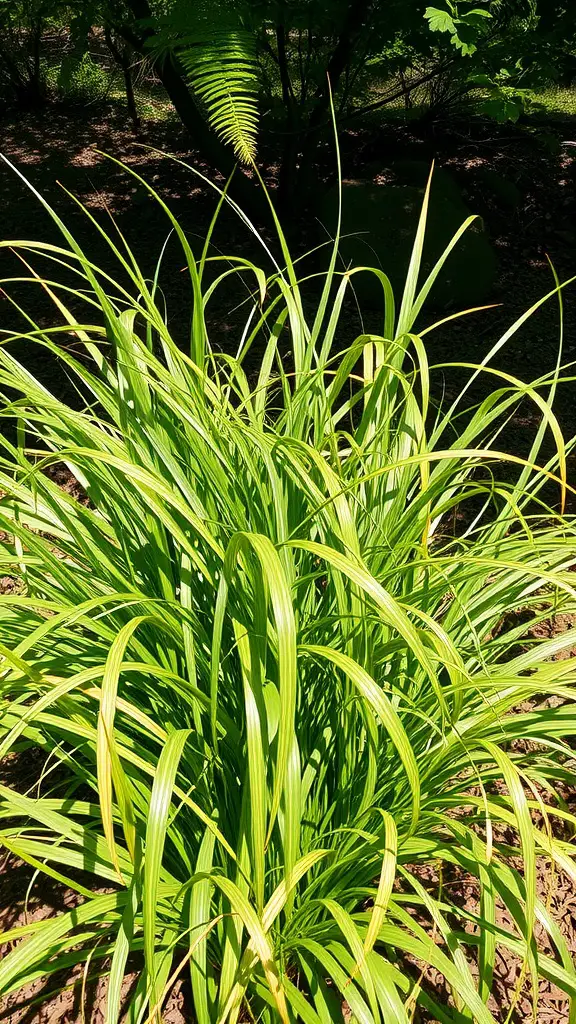
Japanese Forest Grass, celebrated for its graceful form, brings a delicate charm to shady gardens. The picture showcases vibrant, cascading leaves that ripple softly in the wind. It’s ideal for crafting a tranquil and peaceful outdoor setting.
In 2025, this plant’s leaves showcase a beautiful blend of bright green and sunny yellow. This striking contrast pops against darker settings. Its vibrant color brightens shady spots, making it perfect for gardens with little sun.
Japanese Forest Grass flourishes in partial to full shade. Ensure moist, well-drained soil for optimal growth. Once established, it’s remarkably low-maintenance. Regular watering and occasional trimming are all it needs to maintain its beauty.
This grass complements shade-tolerant plants like ferns and hostas perfectly. Plant it in groups for a striking visual effect. It also works well as ground cover to suppress weeds.
Pulmonaria: Low-Maintenance Ground Covers

Lungwort, or Pulmonaria, is a fantastic choice for shady gardens. This image highlights its lovely pink blossoms, rising gracefully above vibrant green foliage. Blooming in early spring, these flowers inject a burst of color, perfect for illuminating any shadowy garden spot.
Pulmonaria’s easy care is a major draw. After it settles in, it needs very little attention. This makes it ideal for gardeners who like a relaxed approach. It grows well in damp, well-drained soil. It can handle different light levels, but partial shade is its favorite.
This plant significantly benefits the garden’s ecosystem. It draws in early pollinators such as bees and butterflies, boosting biodiversity. Its foliage is visually appealing, often displaying unique spots or variegation, enhancing the garden’s texture.
Adding Lungwort to your garden design offers a vibrant, low-maintenance ground cover. It effectively controls weeds and boosts visual appeal. Plant it in groups or as edging for a natural, beautiful look. It pairs well with other plants that thrive in shady areas.
Lobelia: Vibrant Blues for Shade
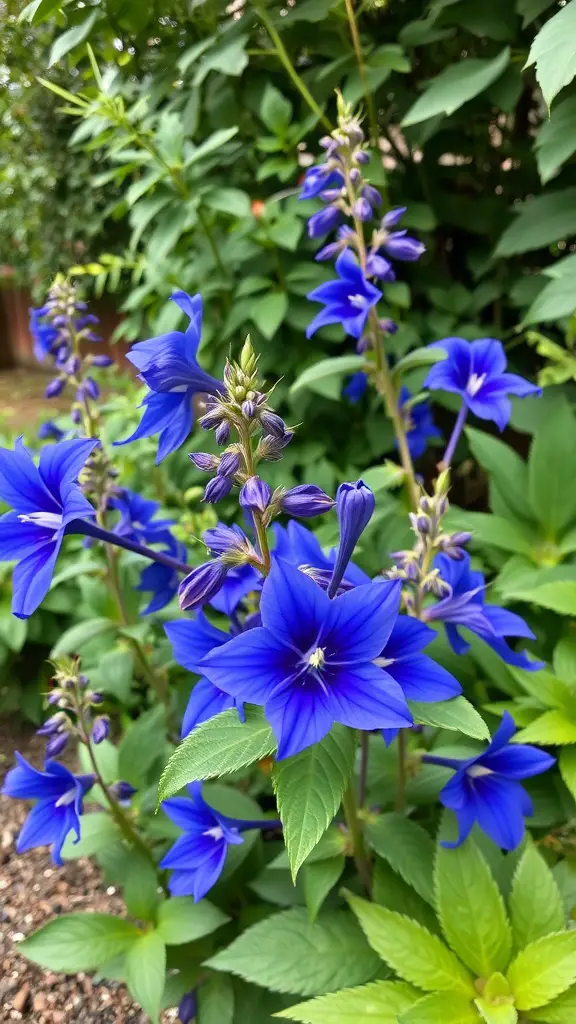
Lobelia is perfect for brightening up any shady garden. Its brilliant blue blooms are visually appealing. They introduce a vibrant splash of color to those often-neglected, darker areas.
Observe vibrant blue lobelia flowers clustered together in this photo. Their distinctive, star-shaped petals offer a delightful visual. They are ideal for edging gardens or creating impactful displays when planted in groups.
In 2025, Lobelia flourishes in damp, well-draining soil. It favors partial to full shade. This makes it ideal for challenging garden spots.
These plants aren’t just visually appealing. They also draw in vital pollinators such as butterflies, boosting your garden’s ecological health.
Ensure ample spacing when planting lobelia. This promotes air circulation, crucial for preventing mold and mildew. With the right care, expect vibrant blooms from spring through the first frost!
Siberian Bugloss: Hardy Ground Cover

Brunnera macrophylla, or Siberian Bugloss, enhances any shady garden. Its rich green foliage provides a beautiful setting for its vibrant blue flowers. The image showcases clusters of these delicate blue blossoms, rising gracefully above the lush leaves.
This plant flourishes in shaded locations. It’s ideal for areas where other plants find it hard to grow. Its round, heart-shaped leaves are visually appealing. They also effectively suppress weeds. This makes Siberian Bugloss an excellent ground cover option.
Beyond its stunning appearance, it’s incredibly easy to care for. Simple watering and infrequent feeding will keep it flourishing. Expect to see bees and butterflies flock to it, bringing your garden to life.
Siberian Bugloss is a tough plant. It thrives in many soil types, but it loves moist, well-drained soil best. This makes it perfect for gardeners who want beauty without the hassle. It’s ideal for filling shady areas with minimal effort.
Bluebells: Classic Spring Blooms
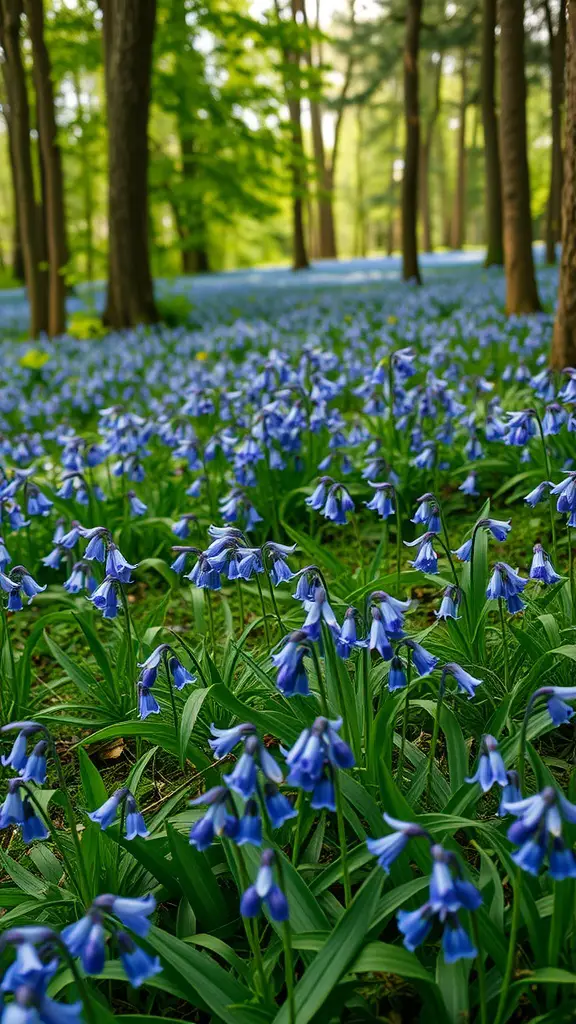
Bluebells herald the arrival of spring, a truly welcome sight. This image showcases a forest floor covered in these lovely blooms. Their delicate, bell-like shapes form a blue carpet. This vibrant color contrasts wonderfully with the surrounding fresh green foliage.
These shade-loving plants are ideal for gardens with limited direct sunlight. Native to Europe, bluebells typically bloom in April and May. Their vibrant colors signal the arrival of warmer weather. They’re easy to cultivate and spread rapidly. This creates beautiful ground cover, enhancing any garden.
Did you know bluebells thrive in woodlands? Imagine strolling through a forest carpeted with these flowers – a true fairy tale experience! They’re also bee magnets, drawn to their delicious nectar.
For thriving bluebells, ensure they’re planted in soil with good drainage. They enjoy some moisture but dislike being waterlogged. After flowering, avoid immediate cutting back. Let the foliage wither naturally; this process helps the plant store energy for future growth.
In conclusion, bluebells offer both beauty and practical advantages for your garden. They thrive in shady areas and provide vital support for native wildlife. For a timeless spring flower that demands little maintenance, bluebells are an excellent option. Consider adding these to your garden in 2025 for a vibrant and ecologically friendly touch.
Shade-Tolerant Roses: Blooming in the Shadows
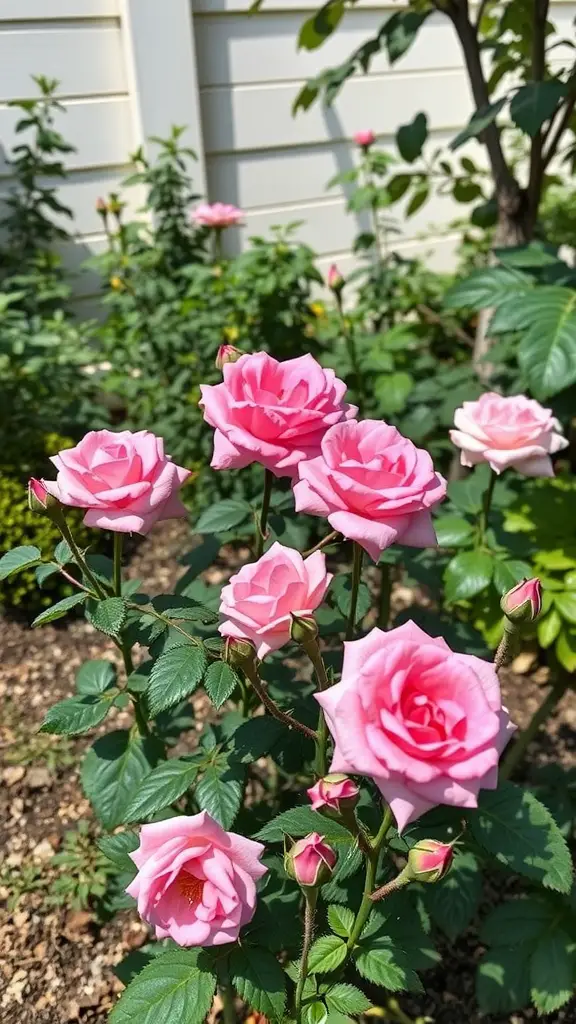
Roses are often associated with full sun, but certain types flourish even in shaded areas. This image displays a beautiful group of pink roses, enjoying soft light, and nestled among vibrant green leaves. These flowers bring beauty and color to any garden, particularly in places with limited sunlight.
Choose shade-tolerant roses such as ‘Knock Out’ or ‘Mister Lincoln.’ These roses are resilient. They bloom beautifully even with little direct sunlight. The image’s pink hues show how vibrant these flowers are. They add beauty even in low-light conditions.
Growing roses in shaded areas requires specific care. Adequate watering is crucial. Mulch helps retain soil moisture. With proper attention, these roses will create a vibrant, fragrant haven in your garden.
Woodland Phlox: Colorful Ground Cover

Woodland phlox is a fantastic choice for gardens, thriving particularly well in shady spots. The picture highlights bright pink and white flower groupings, forming a lively splash of color. Blooming in springtime, these flowers revitalize your garden, spreading beautifully across the ground.
Woodland phlox offers beauty and functionality as a ground cover. It excels in shady areas where sunlight is limited. Its vibrant green foliage complements its colorful flowers, creating a visually stunning display.
Planning to include woodland phlox in your garden? Opt for well-drained soil enriched with organic matter. These plants thrive with consistent moisture, but avoid waterlogged soil. Plant them in groups to mimic their natural habitat. Enjoy the butterflies and pollinators they attract!